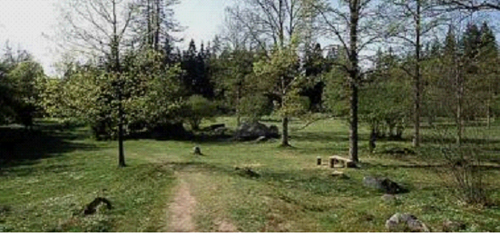Biodiversity and beech forests 2013-05-15
How do we increase biodiversity? By cutting down a number of beeches, so the light comes down to the ground. Then other plants could grow there. Plants need light to live. The beeches blocks the light for other plants, The leaves also covers the ground effectively. If we change beech forest to a park the biodiversity increases. But even an area of low Biological Diversity has its charms, the trees are impressive.
When man interferes in a right way in a natural ecosystem the biodiversity increases. We can have a pasture with richer flowering and species richness of up to 50 different species per square meter. This species richness will never be without human interference. Urban Emanuelsson writes about this in his book about biodiversity in Europe "The early 1900s conservationists put the wildlife high. They were often heavily influenced by an American wilderness romantic attitude. Also, significant portions of today's conservation has ideological wilderness character. Humans just destroy if she comes into context. That many of Europe's most species-rich habitats would be "created" by man can be a bit difficult to accept for those conservationists. "Furthermore, he writes that it is this way of thinking that has led to the international regulations for national parks that have been established. The rules say that national parks should be as untouched by humans as possible, which eventually leads to the cultural landscape is not managed and eventually diappear in growth of certain trees. He also writes "In addition, the critics of natural environment protection wonders a little mockingly if cultural landscapes habitat really is so precious. They're not original and therefore not worthy of protection. "
When man interferes in a right way in a natural ecosystem the biodiversity increases. We can have a pasture with richer flowering and species richness of up to 50 different species per square meter. This species richness will never be without human interference. Urban Emanuelsson writes about this in his book about biodiversity in Europe "The early 1900s conservationists put the wildlife high. They were often heavily influenced by an American wilderness romantic attitude. Also, significant portions of today's conservation has ideological wilderness character. Humans just destroy if she comes into context. That many of Europe's most species-rich habitats would be "created" by man can be a bit difficult to accept for those conservationists. "Furthermore, he writes that it is this way of thinking that has led to the international regulations for national parks that have been established. The rules say that national parks should be as untouched by humans as possible, which eventually leads to the cultural landscape is not managed and eventually diappear in growth of certain trees. He also writes "In addition, the critics of natural environment protection wonders a little mockingly if cultural landscapes habitat really is so precious. They're not original and therefore not worthy of protection. "
Our Swedish ecosystem is not so original, a few thousand years old maximum.
Before the ice had scraped the area clean.
Before the ice had scraped the area clean.
Below you see an area with greater biodiversity than a beech forest.

Now I do not mean that we should start cutting down the remaining beech forests. They are stately and impressive, but if a storm would blow down such forrest or man chop it down and then if it grows up again, during regrowth there are greater biodiversity. Natural disturbances can be for a short time, but creating greater biodiversity.